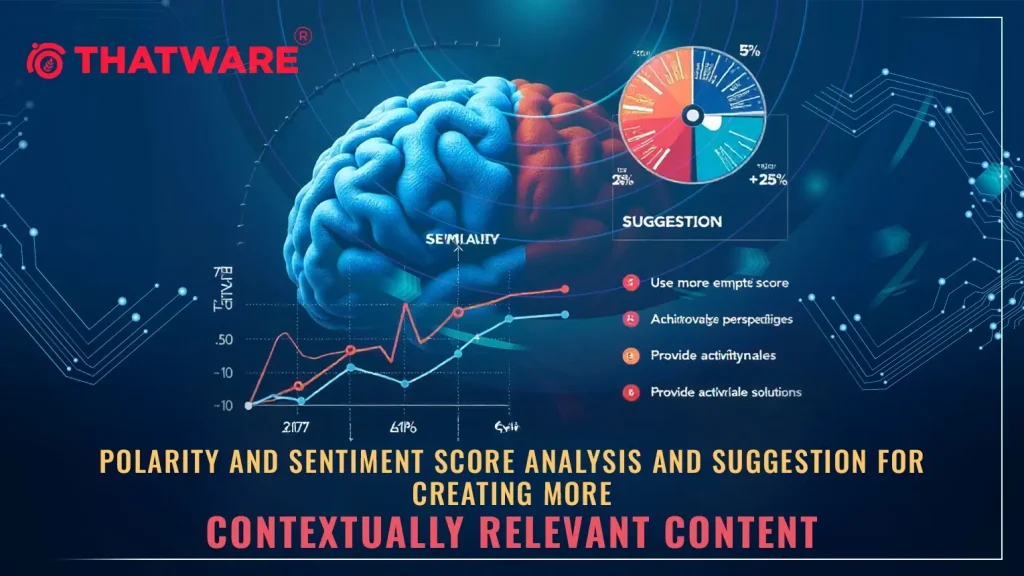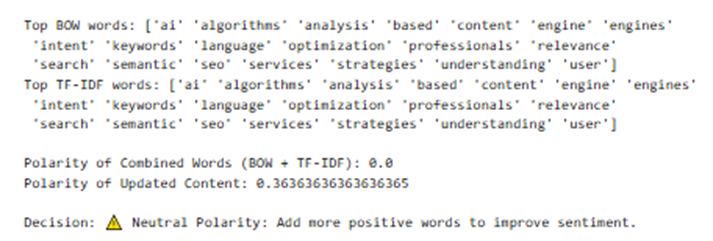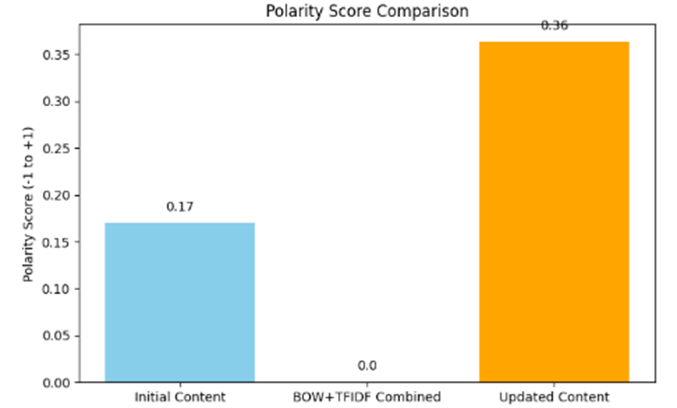Get a Customized Website SEO Audit and Quantum SEO Marketing Strategy and Action Plan
Why Sentiment and Polarity Matter in Content Strategy
Nowadays, the battle for online visibility is no longer just about showing up on search engines. It is about creating content that resonates with real people. A well-structured blog post or campaign may attract clicks, but if the message feels disconnected from the audience’s emotions, the engagement stops there. Relevance has become the currency of trust, and trust is what drives repeat visits, shares, and ultimately conversions.
Not too long ago, content strategies leaned heavily on keyword density and mechanical optimization. Brands could climb search rankings simply by repeating targeted terms, often at the cost of readability and depth. That era has passed. Search engines have matured, and so have audiences. Today, relevance is measured not only by how well a piece aligns with a query, but also by how it speaks to the intent, sentiment, and emotional state behind that query.

This is where Natural Language Processing (NLP) plays a crucial role. By analyzing text at scale, NLP allows marketers to go beyond surface-level keyword usage and understand how people truly feel about a subject. Within NLP, two key measures stand out: polarity and sentiment score. Polarity identifies whether the emotion expressed is positive, negative, or neutral, while sentiment score captures the strength or intensity of that emotion. Together, they offer a more complete picture of how an audience reacts to content, products, or conversations.
For brands, this means a powerful shift. When polarity and sentiment insights are applied thoughtfully, they can guide not only what topics to cover but also how to frame them. The result is content that feels authentic, emotionally intelligent, and contextually relevant. In a world where attention is scarce, this ability to align with the audience’s emotional pulse is what separates forgettable content from content that sparks genuine connection.
The Foundations of Sentiment Analysis
At its core, sentiment analysis is the science of understanding how people feel when they express themselves through text. In the digital world, customers leave their emotions scattered across product reviews, tweets, blog comments, and social media posts. Businesses and content creators rely on sentiment analysis to transform these words into measurable insights. Instead of reading thousands of lines manually, algorithms can detect whether the tone of a sentence leans positive, negative, or sits somewhere in the middle. This is often referred to as text mining, where unstructured data is turned into structured meaning.
One of the first things to understand is polarity. This is the backbone of sentiment analysis. Polarity measures whether a piece of text is positive, negative, or neutral. For instance, take the sentence: “The product is great, but delivery was late.” A person instantly understands the mixed emotions. Polarity helps machines do the same, marking “the product is great” as positive while flagging “delivery was late” as negative. Neutral polarity, on the other hand, would describe statements that are factual or emotionless, such as “The item arrived on Tuesday.”
Closely linked to polarity is the difference between subjectivity and objectivity. Subjective statements are colored by personal opinions or feelings, while objective ones stick to facts. A phrase like “This restaurant has the best pasta in town” is subjective because it depends on personal taste. “The restaurant opens at 11 AM” is objective, since it states a verifiable fact. Understanding this distinction helps algorithms avoid confusing emotional content with plain information.
Sentiment is usually scored on a range, often from -1 to +1. Negative numbers indicate unfavorable sentiment, positive numbers show favorable sentiment, and zero suggests neutrality. This scale makes it possible to assign weight to emotions. A comment like “absolutely fantastic” might score closer to +0.9, while “utterly terrible” could fall near -0.9.
There are different approaches to sentiment analysis. Rule-based systems use predefined dictionaries of positive and negative words to judge tone. These are simple but often miss nuances like sarcasm. Machine learning models learn patterns from large datasets, making them more adaptable. Popular tools include VADER (Valence Aware Dictionary and Sentiment Reasoner), which is often used for social media analysis, and TextBlob, which provides quick polarity and subjectivity scores. More advanced solutions like BERT and RoBERTa use deep learning to understand context at a much deeper level, capturing subtle language variations that traditional tools might overlook.
By combining these methods, sentiment analysis offers a structured way to decode human emotions, helping brands, researchers, and marketers understand not just what people say, but how they truly feel.
Why Context is More Important than Just Sentiment
Many people assume that positive sentiment automatically means good feedback and negative sentiment always signals a problem. This oversimplification can be misleading when creating content. Words carry meaning that depends heavily on context. For example, the word “cheap” might be a positive signal when customers are praising affordability, but it becomes negative if it suggests poor quality. Relying solely on polarity without understanding the surrounding context risks misinterpreting audience feedback and crafting content that misses the mark.
Contextual sentiment analysis digs deeper than just positive or negative labeling. It examines what exactly users are reacting to, identifying the aspects that drive their emotions. Take a simple example from an airline tweet: “The seats were small, but the staff was amazing.” A basic sentiment analysis might assign a neutral or slightly positive score. However, a contextual breakdown reveals a mixed experience. Customers were unhappy with seat size but highly appreciated the service. Brands can use this insight to highlight strong areas, such as customer service, while acknowledging areas that need improvement. This approach allows content creators to address audience concerns more thoughtfully and to emphasize what matters most to users.
The rise of aspect-based sentiment analysis, or ABSA, has transformed the way brands approach feedback. ABSA evaluates sentiment for individual components of a product or service rather than providing a single overarching score. This method enables brands to produce content that is tailored to specific concerns and interests of their audience. For instance, a hotel might learn that guests consistently praise the breakfast but criticize room cleanliness. Using ABSA, content can celebrate the positive aspect while providing updates or solutions for the areas needing attention.
By focusing on context rather than raw sentiment scores, brands can create content that resonates with their audience, fosters trust, and drives engagement. Understanding what aspects matter most and how customers perceive them turns raw feedback into actionable insights.
Polarity and Sentiment Score in SEO and Content Marketing
In today’s content landscape, search engines no longer rely solely on keywords to rank pages. Google emphasizes expertise, experience, authority, and trust, known as E-E-A-T. Alongside this, semantic relevance plays a crucial role, ensuring that content matches the intent and emotional expectations of the audience. Polarity and sentiment analysis offer a powerful way for brands to align with these standards, making content not only discoverable but genuinely resonant.
Polarity helps brands decode the emotional orientation of their audience toward different topics. Positive polarity indicates enthusiasm, satisfaction, or excitement, while negative polarity points to frustration, disappointment, or concerns. Understanding these emotional signals allows brands to identify what topics energize their readers and what causes dissatisfaction. For example, in the health and wellness sector, a brand analyzing reader feedback may find that discussions about diet restrictions generate negative sentiment. This insight enables the brand to pivot its content toward solutions like flexible nutrition plans, making the messaging more audience-friendly.
Sentiment analysis also enables highly targeted content personalization. By categorizing user reactions across segments, brands can create messages that resonate with different emotional profiles. A fitness blog can develop content tailored for readers who respond positively to motivational tips, while addressing concerns of those who feel overwhelmed by strict routines. This approach ensures that every piece of content speaks to the audience’s needs, improving engagement, dwell time, and conversion rates.
The applications of sentiment-driven insights are diverse. For blog creation, polarity analysis helps identify topics that deserve more coverage and angles that need reframing. Social media teams can craft posts that amplify excitement or address common pain points, generating more meaningful interactions. In advertising, sentiment scoring can inform copy testing, revealing which messages evoke the intended emotions and which fail to connect.
Ultimately, integrating polarity and sentiment insights into SEO and content marketing shifts the strategy from simply chasing rankings to building meaningful relationships with readers. Brands that understand the emotional undercurrents of their audience can craft content that is not only relevant but also engaging, trustworthy, and aligned with modern search engine expectations.
Methodologies for Analyzing Polarity and Sentiment Score
Understanding the emotional tone of your audience starts with a structured approach. Analyzing polarity and sentiment scores allows content creators and marketers to transform raw feedback into actionable insights. Here is a practical methodology to achieve this.
Step 1: Data Collection
The first step is gathering text data that reflects authentic audience opinions. This can come from multiple sources. Customer reviews often reveal the most candid responses about products or services. Social media posts provide unfiltered reactions in real-time. Feedback forms capture both qualitative and quantitative impressions. Even snippets from search engine result pages can offer clues about the sentiment surrounding specific topics or keywords. Collecting data from these varied sources ensures a comprehensive understanding of audience feelings.
Step 2: Sentiment Analysis Models
Once data is collected, it needs to be analyzed for emotional tone. Pre-trained libraries such as TextBlob and VADER offer an accessible starting point for understanding positive, negative, and neutral sentiments. For more advanced requirements, API services like Google NLP API and AWS Comprehend can process large volumes of text and detect subtle nuances in sentiment. Choosing the right model depends on the size of your dataset and the level of detail required. Some models excel at detecting sarcasm or mixed sentiment, while others are better for broad trends.
Step 3: Polarity and Scoring
After analysis, assigning a weighted sentiment score helps quantify the intensity of emotions. Scores typically range from -1, indicating strong negative sentiment, to +1, indicating strong positive sentiment. Neutral sentiments sit around 0. These scores can be visualized in multiple ways to reveal patterns at a glance. Bar charts can show the proportion of positive versus negative sentiment. Heatmaps highlight areas of concentrated feedback, and word clouds make it easy to spot recurring themes or phrases that trigger strong emotional responses. Visualization transforms numbers into insight that is easier for teams to interpret and act on.
Step 4: Insights and Content Mapping
The final step is translating sentiment analysis into content strategy. By mapping sentiment drivers to content opportunities, you can tailor messaging that resonates with your audience. For example, if SaaS product reviews reveal negative sentiment toward complex onboarding processes, this signals an opportunity. A content solution could be a quick-start guide that simplifies the onboarding experience. Similarly, if positive sentiment clusters around a specific feature, highlighting it in marketing campaigns or blog posts can reinforce what your audience values most.
This structured methodology ensures that content creation is not guesswork. Every piece of content is informed by real audience reactions, making it contextually relevant and more likely to engage readers meaningfully.
Using Polarity Insights to Create Contextually Relevant Content
Polarity insights are a powerful tool for content creators who want to connect with their audience on a deeper level. By understanding how readers feel about different topics, brands can craft material that resonates emotionally and contextually.
Content Ideation
The first step is identifying the topics that already generate positive sentiment. If a blog, social post, or review consistently receives enthusiastic responses, those themes can serve as a springboard for new content. For example, if customers show excitement around eco-friendly travel tips, a brand can expand that into a series of articles, guides, or even interactive tools. Positive sentiment provides clues about what your audience values, which helps generate fresh, relevant ideas that will naturally attract engagement.
Tone and Voice Optimization
Polarity data can also guide how content should be written. A friendly tone works well for lifestyle or community-driven topics, while an empathetic voice suits content that addresses pain points or frustrations. Authoritative language can reinforce trust when discussing technical or professional subjects. Adjusting tone based on sentiment ensures the content aligns with the audience’s expectations and emotional state, which increases both readability and credibility.
Addressing Negative Polarity
Negative feedback or criticism is not a setback but an opportunity. Analyzing content that receives low sentiment can reveal gaps in understanding or unmet needs. Brands can transform these insights into helpful resources, FAQs, or corrective guides. For instance, if customers frequently complain about confusing product instructions, creating a step-by-step tutorial can address the issue while demonstrating attentiveness and care.
Content Structuring
Mixed polarity content, which includes both positive and negative feedback, benefits from thoughtful structuring. A balanced approach allows readers to see different perspectives, making content appear more authentic. Highlighting pros alongside cons creates a sense of transparency and fosters trust. This strategy is especially useful for reviews, comparisons, and thought leadership pieces where nuanced discussion is valued.
Let’s Understand With This Live Example
What is sentiment?
Sentiment is the emotional tone behind a piece of text (positive, negative, or neutral).
Example:
- “I love this product!” → Positive sentiment
- “This is the worst experience ever.” → Negative sentiment
- “The product arrived yesterday.” → Neutral sentiment
What is polarity?
Polarity score is a numerical value that shows how positive or negative the sentiment is.
Range: Usually between -1 to +1
- -1 → Strongly Negative
- 0 → Neutral
- +1 → Strongly Positive
Example:
- “Amazing service!” → Polarity score: +0.9 (very positive)
- “It was okay, nothing special.” → Polarity score: 0.0 to +0.1 (neutral)
- “Terrible product, waste of money.” → Polarity score: -0.8 (very negative)
In short:
Sentiment tells you the type (positive/negative/neutral).
Polarity score tells you the strength or influence of that sentiment.
Here is a simple example of refining the context and relevance of a page content using Sentiment and Polarity score analysis
Suppose there is a website, www.abc.com
And we want to optimize a page, www.abc.com/best-porlour-delhi
Target keyword “K”=best porlour delhi
Step 1: Now we need to do sentiment analysis for the page, and refurbishing unless we get +ve sentiment
Step 2: Take the final piece of refurbished content
Apply Bag of Words and TF/IDF analysis
We need to make union of the the list of words,
L1, L2, L3, L4
that we have got from the analysis,
Step 3: Now we need to do Polarity score analysis for every list of words we have got with the final piece content.
Fp Vs. L1
Fp Vs. L2
Fp Vs. L3
Fp Vs. L4
Now we may get three conditions,
1. If the Polarity score of the summation of all BOW +TF/IDF is >0 then its, ok we need to take that list.
2. If the Polarity score of the summation of all BOW +TF/IDF is =0 then we just need to add +ve words to the content.
3. And if the polarity score of the summation of all BOW +TF/IDF is <0 for a list, then we need to take following actions.
We need to take at least 10 similar keywords of the exact match target keyword and repeat the whole process to evaluate the final list of words that need to include and reoptimize the content for making it more contextually relevant with positive sentiment and ideal Polarity score.
Here is the Google Colab link for the above analysis:
https://colab.research.google.com/drive/1z5Ksbb_6k7NuH49I5IpL1A9ZZelj3SOf



Advanced Strategies: Beyond Polarity
Understanding the emotional undertone of content goes far beyond simply labeling it as positive, negative, or neutral. Modern content strategies increasingly rely on emotion detection to uncover deeper insights. While sentiment analysis gives a general overview, emotion detection identifies specific feelings such as anger, joy, trust, or anticipation. These nuanced insights allow marketers to craft content that resonates on a personal level, addressing the audience’s precise emotional state rather than making broad assumptions. For instance, a product review might show neutral sentiment overall, but emotion detection can reveal underlying frustration or excitement that a simple score would miss.
Another crucial layer is accounting for cultural and linguistic differences. Words that seem positive in one region might carry a negative connotation elsewhere. For example, describing a product as “cheap” may be appreciated in a cost-conscious market, while in a premium-focused market it could signal poor quality. Understanding these nuances ensures content is locally relevant and prevents misinterpretation that could harm brand perception.
Combining AI with human editorial judgment produces the most reliable results. Automated tools can quickly analyze large datasets for sentiment and emotion, but human oversight is essential to interpret context, sarcasm, or subtle cues that machines might overlook. This hybrid approach balances efficiency with precision, allowing content teams to produce work that is both data-informed and naturally engaging.
Finally, predictive content creation is emerging as a game-changer. By analyzing historical sentiment trends, brands can anticipate audience reactions and shape content before issues arise or opportunities are missed. This proactive strategy enables marketers to stay ahead of evolving preferences, creating material that feels timely, relevant, and emotionally connected.
Incorporating these advanced strategies transforms basic sentiment analysis into a powerful framework for content planning. The goal is not just to measure reactions but to understand them, anticipate future needs, and build a deeper connection with the audience.
Tools, Frameworks, and Practical Tips
Creating content that resonates with your audience requires more than intuition. The right tools, frameworks, and strategies can transform raw sentiment data into actionable insights, helping you craft content that is both relevant and engaging.
Recommended Tools
For those starting out, open-source tools like VADER, TextBlob, and spaCy provide robust sentiment and polarity analysis without heavy investment. VADER excels at analyzing short-form text such as social media posts, while TextBlob is ideal for quick polarity scoring and subjectivity detection. SpaCy offers more advanced NLP capabilities, enabling deeper contextual understanding and custom model training for niche industries.
Enterprise solutions are better suited for larger teams or brands that need scalability and real-time monitoring. Platforms such as Brandwatch, Talkwalker, and MonkeyLearn provide dashboards for tracking sentiment trends, analyzing customer conversations, and integrating insights across marketing campaigns. These tools can reveal which topics generate excitement, frustration, or confusion, allowing content teams to respond with precision.
Content Frameworks
Once sentiment data is collected, frameworks help translate insights into content strategies. Polarity-driven keyword mapping involves aligning your content around terms that evoke strong positive sentiment while addressing areas of negative sentiment to build trust and transparency. Content gap analysis identifies topics or concerns that audiences frequently mention but are not sufficiently addressed in existing content. Filling these gaps strengthens authority and improves relevance.
Practical Tips for Creators
Effective content creation requires careful attention to balance. Always consider both positive and negative feedback to ensure your content reflects reality and resonates authentically. Visualization dashboards can help editorial teams track sentiment trends over time, making it easier to plan campaigns and prioritize topics that matter most to readers. Finally, language evolves quickly, and so should your polarity models. Regularly updating them ensures that your analysis keeps pace with changing expressions, cultural nuances, and industry jargon.
By combining the right tools, structured frameworks, and thoughtful execution, content creators can move beyond generic messaging to produce material that connects, informs, and engages readers on a deeper level.
Conclusion: The Future of Polarity and Sentiment in Content
As content strategies evolve, sentiment analysis has emerged as the next step beyond traditional keyword targeting. Understanding not just what words users search for, but how they feel about topics, allows brands to craft messages that resonate on a deeper, more meaningful level. Polarity and sentiment insights offer a window into the emotional undercurrents behind every review, comment, or social media post. This knowledge empowers content creators to develop material that is not only informative but also personalized and emotionally intelligent.
By leveraging polarity data, brands can deliver content that aligns with the audience’s mindset, addresses concerns before they escalate, and highlights experiences that spark positive engagement. Contextually relevant content built on these insights fosters stronger connections, increases trust, and ultimately drives action. The digital landscape is moving toward search engines and platforms that prioritize emotion-aware content, rewarding brands that understand user intent at a nuanced level. Predictive audience modeling, powered by sentiment trends, is helping marketers anticipate needs, craft tailored messaging, and stay ahead of competitors.
For businesses and creators, adopting polarity and sentiment analysis is no longer optional. It is a strategic tool to transform content from generic messaging into experiences that truly connect with audiences. Those who embrace these insights will be able to inform their strategies with precision, create content that feels human and relatable, and achieve a level of engagement that goes beyond clicks. Sentiment-driven content is the bridge between data and empathy, turning information into influence and relevance into results.
Click here to download the full guide about Polarity & Sentiment Score Analysis.

